Facebook Ads has solid targeting capabilities. Where to start?
Thanks to Facebook’s powerful targeting capabilities, marketers can instantly reach current and prospective customers. From basic demographics to specific interests, there are endless possibilities to connect with the audiences that matter most to your brand.
The question becomes, who are you targeting, and what’s the rationale behind it? Here are a few tips to keep in mind when developing an effective Facebook advertising strategy.
Set Goals For Your Facebook Ads Campaigns
Before you dive into the deep end, it’s important to define your Facebook advertising goals and ensure they align with your overarching business goals.
Even if you create the best ad in the world, it won’t do you any good if you don’t serve it to the right people. The campaign purpose you select will dictate your targeting approach.
For instance, if you want to increase likes and brand awareness, you may want to cast a wide net using targeting criteria, such as location, age range, and gender. On the other hand, a more precise purpose, like increasing membership registration, often requires targeting a tighter, niche audience to generate more valuable leads. Narrowing criteria may include tactics like zip code targeting, interests, and users who follow particular groups.
Luckily, Facebook Ads Manager makes this easy for you. The platform caters to six different objectives for your campaign, which you can easily choose right at the start of your ad creation process.
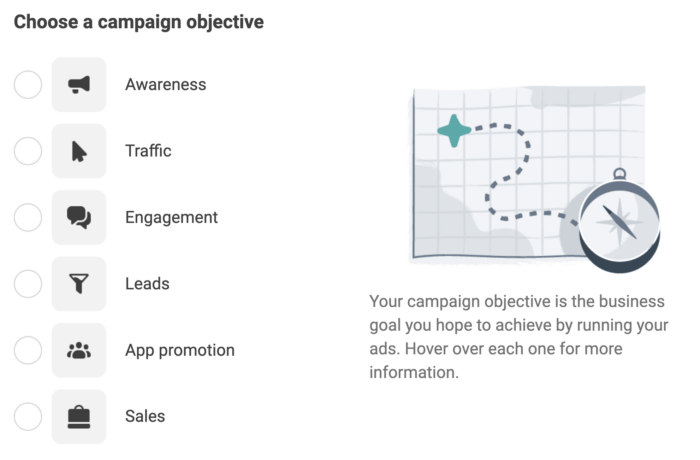
Define Your Core Audience
Before you can begin targeting, though, you need to first define your ideal customer.
Start by asking yourself: who are the people I’m trying to attract to my brand? Using basic demographics, like age range, gender, race, geographic location, income level, education level, economic status, interests, and more, begin shaping the profile(s) of your target audience.
Create Persona Profiles
Then, use basic demographics to construct a more specific persona profile. For the purposes of this guide, let’s create two hypothetical profiles: one for a fictional company and one for their ideal target customer, or persona.
Company Profile
Brand: “The Future is Fitness”
Fictional Company: “The Future is Fitness,” a women’s only gym in Portland, Oregon that primarily teaches body resistance training and yoga.
Profile: The gym prides itself on being environmentally conscious and hires trainers with exclusive credentials, resulting in a steep monthly price tag.
Goal: Double membership in the first quarter
Advertising Strategy: Locate adult females in the greater Portland metro area looking to lose weight and tone their bodies. Encourage them to sign up for a trial membership.
Persona Profile
Target Customer: “Jane”
Basics: Jane, aged 45, is a single mother of two (one in middle school, one in high school).
Profile: When she has free time outside of her desk job as a software engineer, she loves to contribute to her community garden, go on local hikes, volunteer at the schools, cook new recipes, and gather with girlfriends for wine night or book club.
Why Jane? Jane’s profession suggests she may have the right income to justify a monthly gym membership expense. Her hobbies indicate she is social and enjoys a balanced lifestyle, open to physical activity as well as enjoying food and drink. These are qualities that may make a women’s only gym appealing to Jane. Advertising content encouraging a free trial in her area that aligns with her interests may inspire her to click and sign up.
Jane’s persona may seem oddly specific, but profile development is a best practice many successful brands use. While not every target customer will exactly match “Jane,” this exercise helps marketers think about a living, breathing person on the other end of the ad, rather than just a list of qualities. Persona profiles help steer companies like “TFF” in the right direction to target people who align with the brand’s values and indicate high revenue potential for the brand. Don’t forget that you can create more than one persona profile if appropriate for your target demographic.
Take A Detailed Targeting Approach
Facebook has the most sophisticated targeting tools on the market. It’s a great place to discover and reach new audiences with your message. Keep your “Jane” persona in mind as you experiment with interest-based targeting.
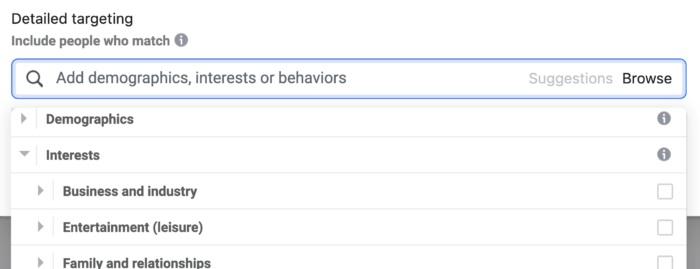
Start by putting yourself in Jane’s shoes. Think about all of the specifics we created in her profile, and consider what she might talk about or “like” while using Facebook. Self-reported data, such as Jane identifying as a woman in her profile, and the content of her status updates and comments all contribute to Facebook’s interest data about Jane.
Just because she may want to get physically fit doesn’t mean Jane will actively talk about it online with family and friends. This missing data point means that she wouldn’t likely be shown TFF’s ads if they only targeted women in Portland who are interested in weight loss. However, if you creatively think about the other topics she may be writing about or subscribing to on Facebook, like raising children or gardening, TFF may be able to serve her the ad if they target women in Portland with similar interests to hers.
Use Personas to Set Up Your Facebook Campaigns
With your target persona(s) in mind, it’s time to create your audience in Meta Ads Manager. Start with the basic demographic information, such as location, age, and gender of your persona. Facebook recommends starting with those broad details to ensure your audience size is large enough — between two and 10 million people — for optimal results.
From there, you can get more detailed about the traits you want your audience to have. This could be anything from their interests and occupation to their education level and relationship status. Use your persona to guide you but also be sure to keep an eye on Facebook’s audience meter. This will let you know whether your audience is too narrow, too broad, or just right.
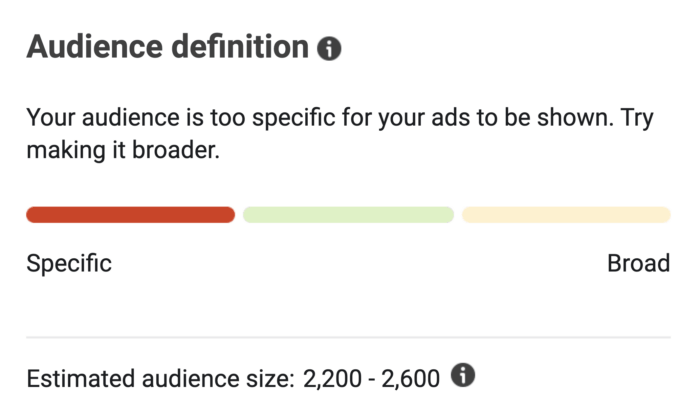
Don’t hesitate to create multiple audiences and campaigns. This strategy may seem like a long stretch at first, but by keeping tabs on which audience segments are responding to your ads, you can adjust ad spend and shut off underperforming audience segments. After you list out the demographic information for your target audience (location, gender, age, language), try creating different Facebook audience segments based on interests.
As an example, for Jane’s persona, try creating an ad set that targets each of the persona’s interests:
- Gardening
- Volunteering and/or Community Issues
- Wine
By creating an ad set for each of these interests, you can learn if gardeners are more expensive to target, more or less engaged, or more likely to convert than wine enthusiasts and volunteers. It allows you to adjust how you’re targeting gardeners to get a better response or turn off that segment of the campaign altogether.
When you use one target audience that includes all three interest groups, over time Facebook’s algorithm will figure out which segments are most likely to achieve your objective (you set the objective when you create an ad) and only show your ad to that group. Facebook will ‘optimize out’ some of your interest groups and assigned demographics. Optimization is ideal for conversion, but it doesn’t allow you to learn if a segment, or interest group, say, gardeners, is a segment of the market you should focus your advertising on. Since this optimization is working behind the curtain, it prevents you from making critical testing decisions, like testing new ads to increase the engagement of gardeners or cutting them out altogether.
Create Custom Audiences and Lookalike Audiences
In addition to being able to refine your audience by demographics, location, and interest, Facebook also offers two additional targeting features that take your current leads or customers into account: Custom Audiences and Lookalike Audiences.
With Custom Audiences, you can reconnect and engage with those who have previously shown interest in your business. This is done by connecting or uploading a specific data source to find that existing audience on Facebook, allowing you to target and show ads to:
- Website visitors
- App users
- Users on your customer list
- Users who have engaged with your profiles and content
This feature is incredibly powerful for nurturing leads and building loyalty. By engaging with your existing customers or visitors on their preferred social media platforms, you not only strengthen your brand’s presence but also uncover opportunities to increase order frequency, improve customer lifetime value, and inspire greater loyalty.
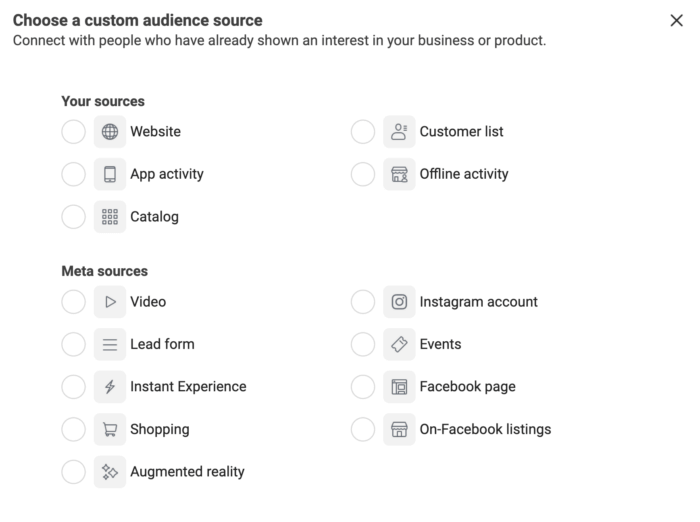
Once you’ve got a solid Custom Audience strategy down, try creating a Lookalike Audience. This is a feature in which Facebook analyzes your Custom Audience to create a new audience that resembles those Facebook users who have already shown an interest in your business. This process takes six to 24 hours, with the Lookalike Audience refreshing every three to seven days to keep up with any changes to your custom audience.
Craft Content for Your Target Customer
Deeply developed persona profiles help you create content that resonates with your target demographic. There are plenty of advertising mistakes that beginners make and missing the mark on content is a big one.
As you write copy and develop visuals for your target audience, create content that speaks directly to Jane (and others just like her). For example, if TFF targeted Jane by sending the ad to women who love hiking, smart ad content may mention getting fit in the gym to prepare for a challenging local hike. Critical thinking about creating a message for ‘Jane’ will make the content more relevant and increase the chance that she’ll engage with TFF.
For instance, while the two brands below both sell workout equipment, their ad copy and visuals are different. Clearly, their target audiences differ, as well, with Aviron focusing on people who struggle with staying engaged with their workouts and NordicTrack targeting those who value unique and personalized experiences.
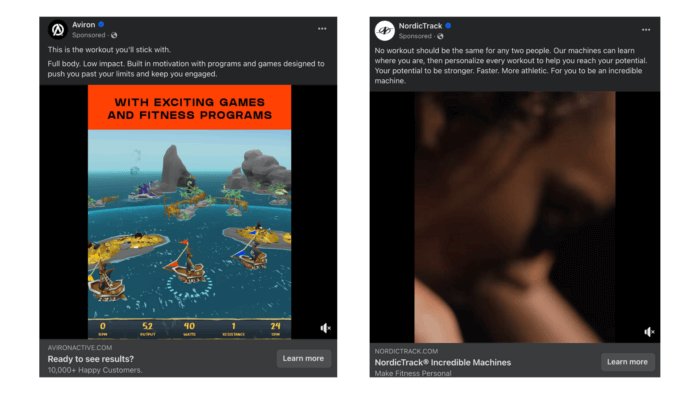
As always, testing ad variations and optimizing the top-performing one for each character profile is the most effective method to get the biggest bang for your buck. Don’t be afraid to try different creative, images, and targeting to see which combinations perform best. A comprehensive approach and A/B testing help you determine which combinations people respond to best and produce results.
Improve Results With Ad Relevance Diagnostics
If you want to improve underperforming ads, reviewing Facebook’s ad relevance diagnostics can be a big help. The idea here is that the more relevant an ad’s content is to its audience, the better it will perform. By reviewing your ad relevance diagnostics, you can determine whether a poorly performing ad can be improved by adjusting the quality of the creative, the post-click experience, or your audience targeting.
With this diagnostic, Facebook reports your performance in three areas:
- Quality ranking
- Engagement rate ranking
- Conversion rate ranking
So, for instance, your ad might receive an average or above average score in quality and conversion rate ranking, but below average in engagement rate. According to Facebook’s nifty chart for interpreting these results, this would mean that the ad isn’t generating interest. Their recommendation for better results? To improve the ad’s relevance to your audience or by targeting an audience that would be more receptive to your ad.
All in all, don’t get discouraged if you’re not meeting your advertising objectives. Using Facebook ad targeting and diagnostics features is a great way to create targeted ads that appeal to your audience personas and optimize your campaigns to get the results you want.
Have you created a target audience persona profile for your ideal customer(s) and had great success with Facebook ads? Or, has a company ever effectively targeted you as a customer? We’d love it if you shared your experiences in the comments.
This post was originally published in 2017 and has since been updated.
